Using Widgets: Horizontal Value Bar
The Mosaic class WidgetSet::HorizontalValueBar implements a GUI component intended to serve as a Horizontal Value Bar widget. This widget can be used to compose the appearance of other more complex GUI components, in particular to add to them controls intended to display an integer value (e.g. measured value) by using a needle as pointer that moves horizontally along a track. Accordingly, the track areas on the left and on the right of the needle appear as separate horizontal bars. The user can't interact with the widget.
The exact appearance and behavior of the Horizontal Value Bar is determined by a Horizontal Value Bar Config object. This configuration object provides bitmaps, colors and other configuration parameters needed to construct and display the affected Horizontal Value Bar. Embedded Wizard is delivered with a set of prepared Horizontal Value Bar Config objects you can use instantly as they are. However, if desired, you can create your own configuration objects and so customize the Horizontal Value Bar widgets according to your particular design expectations. The following screenshot demonstrates few examples of how Horizontal Value Bars appear in the canvas area of Composer (and accordingly on the screen in your target device):
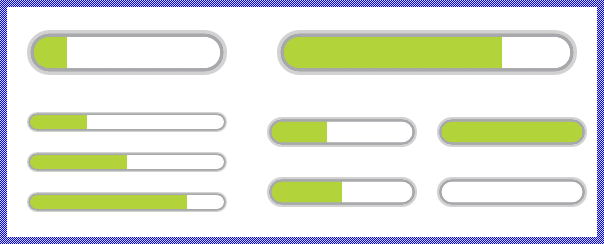
The following sections are intended to provide you an introduction and useful tips of how to work with and how to customize the Horizontal Value Bars. For the complete reference please see the documentation of the WidgetSet::HorizontalValueBar and WidgetSet::HorizontalValueBarConfig classes.
Add new Horizontal Value Bar
To add a new Horizontal Value Bar widget just at the design time of a GUI component do following:
★First ensure that the Templates window is visible.
★In Templates window switch to the folder Widgets.
★In the folder locate the template Horizontal Value Bar.
★Drag & Drop the template into the canvas area of the Composer window:
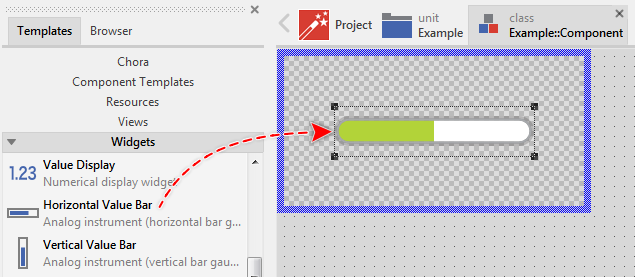
★Eventually name the new added Horizontal Value Bar widget.
Inspect the Horizontal Value Bar
As long as the Horizontal Value Bar widget is selected you can inspect and modify its properties conveniently in the Inspector window as demonstrated with the property Bounds in the screenshot below:

This is in so far worth mentioning as all following sections describe diverse features of the Horizontal Value Bar widget by explicitly referring to its corresponding properties. If you are not familiar with the concept of a property and the usage of Inspector window, please read first the preceding chapter Compositing component appearance.
Arrange the Horizontal Value Bar
Once added, you can freely move the Horizontal Value Bar, or you simply grab one of its corners and resize it in this way. You can control the position and the size of the widget also by directly modifying its property Bounds. If you want the Horizontal Value Bar to appear behind other views you can reorder it explicitly.
Select the appearance for the Horizontal Value Bar
The appearance and partially also the behavior of the Horizontal Value Bar widget can be configured according to your particular design expectation. For demonstration purpose and to help you to quickly create new product prototypes, Embedded Wizard contains three ready to use configurations you can use instantly. All three configurations have in common the same design and they differ only in the available sizes small, medium and large. The following figure demonstrates the three available default configurations at once:
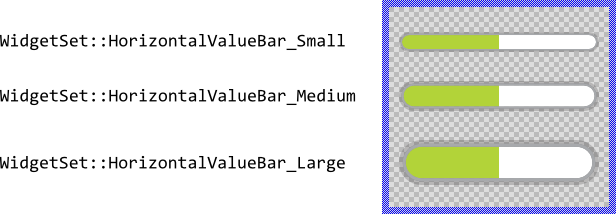
To use the desired appearance configuration you have to select it in the property Appearance of the affected Horizontal Value Bar widget as demonstrated in the screenshot below. You can use the integrated Inspector Assistant window to conveniently select the right configuration. If you like the provided default configurations then you can use them as they are:
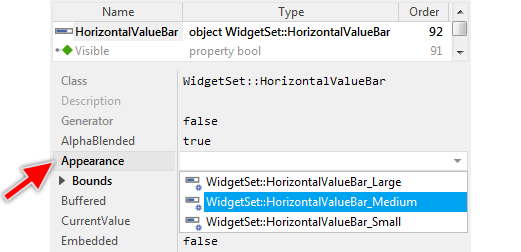
If you prefer to adapt the appearance of the Horizontal Value Bar by yourself, then you have to create a new Horizontal Value Bar Config object and specify in it all the bitmaps, colors as well as other parameters to customize your individual Horizontal Value Bar. Once your configuration object is available, you can select it in the property Appearance exactly as you select one of the configurations provided per default with Embedded Wizard.
Determine the value range and the current value of the Value Bar widget
The Horizontal Value Bar widget is intended to display an integer value by using a needle as pointer that moves along a track. The track areas on the left and on the right of the needle appear as separate horizontal bars. The position of the needle and accordingly the ratio between the width of the left and the right track areas is reflected in the widget's property CurrentValue. By evaluating this property you can simply query the value which is actually displayed in the affected value bar. When you modify the property CurrentValue, the value bar will implicitly update the position of its needle as well as the width of the both tracks (Please note, depending on the selected configuration, the value bar may appear without the needle or without the tracks).
The possible value range for the property CurrentValue is determined by the both properties MinValue and MaxValue, whereby the value specified in the property MinValue corresponds to the leftmost position of the needle and the value of the property MaxValue to the rightmost position. Thus, the value of the property CurrentValue lies always between MinValue and MaxValue. The following figure demonstrates the relations between the three properties:

The value MinValue has not to be necessarily less than MaxValue. If your application case it requires, you can initialize MinValue so that it is greater than MaxValue. For example, you can configure MinValue to be 100 and MaxValue to be 0. Then when the value bar's CurrentValue is getting smaller, the needle moves from left to right. However, you should note, that when initializing MinValue and MaxValue with the same value, the possible value range is empty and the widget will not work.
Connect the Horizontal Value Bar with a data provider
To simplify the development of GUI applications, the Horizontal Value Bar implements a technique permitting you to connect the widgets directly to a data provider. Once connected, the value bar will remain in sync with the value stored actually in this provider. This technique corresponds to the model-view-controller (MVC) programming paradigm, where the Horizontal Value Bar has the function of the view and the associated data provider serves as model. If you associate in your application several Horizontal Value Bars to one and the same data provider value, the underlying mechanisms will ensure, that all affected value bars do update their state automatically.
The connection between the Horizontal Value Bar and the data provider is established by assigning to the Horizontal Value Bar's property Outlet a reference to a property existing within the data provider and storing the interesting value. Since Horizontal Value Bar is intended to deal with integer values, the property suitable to be connected via reference to the value bar has to be declared with int32 as its data type. Accordingly, the value of the referenced property corresponds to the value bar's current value.
Summarized, after assigning a reference to an existing int32 property to the Horizontal Value Bar's own property Outlet, the value bars adapts its own state to automatically correspond to the actual value of the associated property. You don't need to write a single line of code to benefit from this mechanisms. The aspects underlying this technique are explained in the sections Outlet properties and Notifications and Observer.
The following example demonstrates the practical application case with several Horizontal Value Bars connected to a common int32 property serving as data provider. When you download and start the example, you see two value bars, an Image view and an additional slider with it the value can be modified. The value bars and the slider are connected to the Image view's property Opacity. When you drag on the slider, the state of the property changes (the image appears more or less transparent) and the both value bars are updated accordingly:
Please note, the example presents eventually features available as of version 9.00
Arrange other views on the Value Bar's needle
Unlike other widgets like the Toggle Button, the Horizontal Value Bar has no additional label nor icon, which can serve as decoration to give the user an idea of the function behind this widget. If you want such additional decoration, please use the available views. For example, you can add a Text view and arrange it above or below the value bar, as you prefer. This Text view could serve then as a label.
In particular situations, however, you will want the additional decoration views to be automatically arranged at predetermined positions. For example, you can arrange the views to appear always side by side of the needle, so that when the needle position changes, the views are moved accordingly. The WidgetSet::HorizontalValueBar class provides for such application cases various useful methods. The following table gives you a short overview of them:
Method |
Description |
|---|---|
Returns the actual position of the needle center. |
|
Returns the leftmost possible position of the needle center (left end of the needle movement range). |
|
Returns the rightmost possible position of the needle center (right end of the needle movement range) |
You can call those methods whenever your GUI component implementation requires the corresponding information. More sophisticated, however, is to join the update mechanism provided natively by the Horizontal Value Bar widget. Precisely, when you assign a slot method to the value bar's property OnUpdate, the slot method will receive postsignals every time the needle's position changes. Accordingly, within the slot method you can react on this notification and e.g. arrange other views at the new position. The following steps describe how to do this:
★First add a new slot method to your GUI component.
★Assign the slot method to the property OnUpdate of the Horizontal Value Bar widget.
★Open the slot method for editing.
★In the Code Editor implement your desired arrangement algorithm by using the values returned from the above described Horizontal Value Bar methods.
Assuming, your GUI component contains a Horizontal Value Bar named TemperatureBar and a Text view named TemperatureLabel. Furthermore let's assume you want the Text view to appear arranged automatically just below the needle separated by an additional small margin. In such application case implement the slot method with following Chora code:
// Get the current position of the needle and arrange the Text view just below centered // horizontally and separated by a margin of 30 pixel. TemperatureLabel.Bounds.origin = TemperatureBar.GetNeedlePosition() + point( -TemperatureLabel.Bounds.w / 2, 30 ); // If you want, you can also adapt the text to be displayed in the view depending // on the current value of the associated widget. TemperatureLabel.String = string( TemperatureBar.CurrentValue ) + " °C";
With such implementation, every time the needle in the Horizontal Value Bar changes its position, the Text view is updated automatically. The decoration views follow automatically the movements. This is even true if the value bar is configured to display only the bars without any needle. The position where the both bars join together corresponds to the position where the needle would appear:
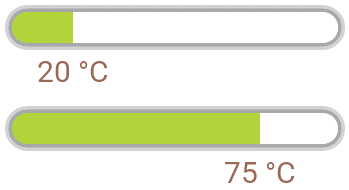
The following example project demonstrates this application case. When you download and open the example, you will see two Horizontal Value Bars with their associated and automatically arranged Text views:
Please note, the example presents eventually features available as of version 9.00
Control the visibility of the Horizontal Value Bar
If desired, you can hide the Horizontal Value Bar so it is not visible to the user. You achieve this by setting the property Visible of the affected value bar to the value false. Please read the section Control the visibility of nested components for further details and more precise explanation.
Customize your own Horizontal Value Bar
Newly added Horizontal Value Bars use an appearance configuration provided per default with Embedded Wizard installation. As described above these default configurations are available in three different sizes you can select easily. If you like them, you can use them as they are. However, should the value bars in your GUI design have another appearance, then you will need to provide your own appearance configuration.
To provide a new configuration you create an object of the class WidgetSet::HorizontalValueBarConfig and initialize its properties with all the bitmaps, colors and other parameters particular to your own design. Once this object is available, you can assign it to every Horizontal Value Bar you want to appear with this configuration similarly as you select one of the per default provided configurations. If necessary, you can create several different configuration objects and use them simultaneously within your application. You can even customize every Horizontal Value Bar instance individually.
Before you start to customize your own Horizontal Value Bars you should understand from which views the Horizontal Value Bars are composed of. In the configuration object you can individually specify parameters for every view. Understanding this internal structure is thus essential. The following table provides an overview of the views existing internally within every Horizontal Value Bar:
View name |
Description |
|---|---|
Face |
A bitmap frame view filling vertically centered the entire width in the background of the value bar. |
TrackLeft |
A bitmap frame view filling vertically centered the background of the value bar between its left edge and the actual position of the needle. |
TrackRight |
A bitmap frame view filling vertically centered the background of the value bar between the actual position of the needle and the right edge of the value bar widget. |
Needle |
An image view displayed vertically and horizontally centered at the needle position according to value bar's current value. |
Cover |
A bitmap frame view filling vertically centered the entire width of the value bar and covering so eventually the Needle and the TrackLeft and TrackRight views. |
The following figure demonstrates once more the above described views existing internally in every Horizontal Value Bar. Please note how the views are arranged one above the other. Accordingly, the Face view resides always in the background of the widget while the view Cover is displayed above all other views:

Please note, the set of views existing within the Horizontal Value Bar as well as the order in which the views are arranged is finished implemented in the Horizontal Value Bar component and can't be modified. With the configuration object you can customize the appearance of the affected views only. Adding new views or changing their Z-order is not possible. In such case and in all other cases when you expect the Horizontal Value Bar to appear and behave beyond our default implementation, you will need to implement your own value bar component. Please see the section Widgets versus Component templates.
The following sections are intended to provide you an introduction and useful tips of how to work with the Horizontal Value Bar Config object. For the complete reference please see the documentation of the WidgetSet::HorizontalValueBarConfig class.
Add new Horizontal Value Bar Config object
Depending on your application case, you have the option to add the configuration object as an embedded object directly to a GUI component or to add it as an autoobject to a unit. The first case is suitable if you want the configuration object to be used only by Horizontal Value Bars existing locally within the GUI component. The second case, in turn, is appropriate if you intend to share the configuration object among multiple GUI components like a kind of common resource.
To add a new Horizontal Value Bar Config object do following:
★Depending on your preferred option switch to the Composer page for the respective GUI component class or the unit where you want to add the Horizontal Value Bar Config object.
★Then ensure that the Templates window is visible.
★In Templates window switch to the folder Resources.
★In the folder locate the template Horizontal Value Bar Config.
★Drag & Drop the template into the Composer window:
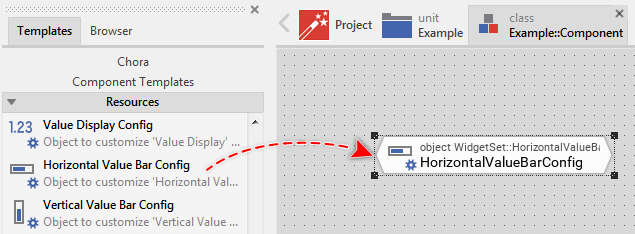
★Eventually name the new added Horizontal Value Bar Config object.
Inspect the Horizontal Value Bar Config object
As long as the Horizontal Value Bar Config object is selected you can inspect and modify its properties conveniently in the Inspector window as demonstrated with the property Face in the screenshot below:
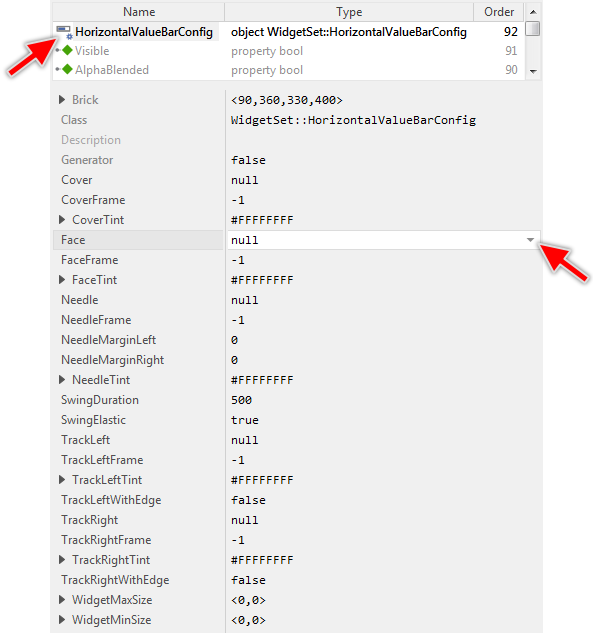
This is in so far worth mentioning as the following sections describe diverse features of the Horizontal Value Bar Config object by explicitly referring to its corresponding properties. If you are not familiar with the concept of a property and the usage of Inspector window, please read first the preceding chapter Compositing component appearance.
Specify the bitmap and color for the Value Bar's face image
As explained in the section above the Face view occupies vertically centered the entire width in the background of every Horizontal Value Bar. With the following properties you specify the bitmap resource as well as other parameters to be used by this view. In other words, you use them to configure the appearance of the Horizontal Value Bar's background:
Property |
Description |
|---|---|
With this property you specify the bitmap resource the Horizontal Value Bar has to display in its background Face view. |
|
This property is relevant only if the bitmap resource specified in the above described property Face contains more than one frame. In such case you use it to determine the desired frame number. Is the bitmap additionally configured as containing an animated sequence you can initialize the FaceFrame property with the value -1 to instruct the Horizontal Value Bar to automatically play the animation. |
|
The effect of this property depends on the type of the bitmap resource specified in the above described property Face. In case of an alpha-only bitmap you use this property to determine the color to tint the bitmap. In all other cases you can use the alpha value of FaceTint property to simply modulate the opacity of the bitmap. |
The specified bitmap will fill vertically centered the entire width of the Horizontal Value Bar. This is achieved by so-called 9-slice image scaling technique where the intended destination area is filled with slices copied from the original bitmap. In case of the Horizontal Value Bar, however, the slices are copied horizontally only. In the vertical direction, the bitmap retains its original height and it is just centered within the background area. Therefore, if you want the Horizontal Value Bar to be flexibly resizable, you have to ensure that the used Face bitmap is composed of three equally sized slices arranged in a single row as shown in the following figure. You should consider this aspect when designing the bitmap in a graphic editor:
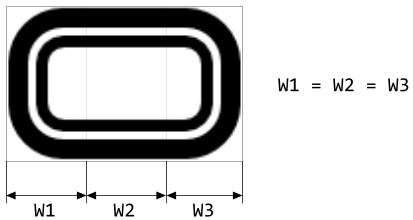
In turn, if the bitmap in the background of your Horizontal Value Bar is intended to always have the same fixed width, you can ignore the above bitmap design restrictions. Just design your desired bitmap and explicitly define size constraints for the widget itself to ensure, that its width is fixed and it corresponds to the of the used Face bitmap.
If you leave the property Face initialized with null, the Horizontal Value Bar will appear without any background.
Specify the bitmap and color for the Value Bar's left track image
As explained in the section above the TrackLeft view occupies vertically centered the background area of the value bar between its left edge and the actual position of the needle. With the following properties you specify the bitmap resource as well as other parameters to be used by this view. In other words, you use them to configure the appearance of the track displayed on the left of the value bar's needle:
Property |
Description |
|---|---|
With this property you specify the bitmap resource the Horizontal Value Bar has to display in its background TrackLeft view. |
|
This property is relevant only if the bitmap resource specified in the above described property TrackLeft contains more than one frame. In such case you use it to determine the desired frame number. Is the bitmap additionally configured as containing an animated sequence you can initialize the TrackLeftFrame property with the value -1 to instruct the Horizontal Value Bar to automatically play the animation. |
|
The effect of this property depends on the type of the bitmap resource specified in the above described property TrackLeft. In case of an alpha-only bitmap you use the property to determine the color to tint the bitmap. In all other cases you can use the alpha value of the TrackLeftTint property to simply modulate the opacity of the bitmap. |
The specified bitmap will fill vertically centered the Horizontal Value Bar between its left edge and the actual needle position. This is achieved by so-called 9-slice image scaling technique where the intended destination area is filled with slices copied from the original bitmap. In case of the Horizontal Value Bar, however, the slices are copied horizontally only. In the vertical direction, the bitmap retains its original height and it is just centered within the value bar's area. Therefore, you have to ensure that the used TrackLeft bitmap is composed of three equally sized slices arranged in a single row as shown in the following figure. You should consider this aspect when designing the bitmap in a graphic editor:

If you leave the property TrackLeft initialized with null, the Horizontal Value Bar will appear without any track on the left side of the needle.
Specify the bitmap and color for the Value Bar's right track image
As explained in the section above the TrackRight view occupies vertically centered the background area of the value bar between the actual position of the needle and the value bar's right edge. With the following properties you specify the bitmap resource as well as other parameters to be used by this view. In other words, you use them to configure the appearance of the track displayed on the right of the value bar's needle:
Property |
Description |
|---|---|
With this property you specify the bitmap resource the Horizontal Value Bar has to display in its background TrackRight view. |
|
This property is relevant only if the bitmap resource specified in the above described property TrackRight contains more than one frame. In such case you use it to determine the desired frame number. Is the bitmap additionally configured as containing an animated sequence you can initialize the corresponding TrackRightFrame property with the value -1 to instruct the Horizontal Value Bar to automatically play the animation. |
|
The effect of this property depends on the type of the bitmap resource specified in the above described property TrackRight. In case of an alpha-only bitmap you use the property to determine the color to tint the bitmap. In all other cases you can use the alpha value of the TrackRightTint property to simply modulate the opacity of the bitmap. |
The specified bitmap will fill vertically centered the Horizontal Value Bar between the actual needle position and the value bar's right edge. This is achieved by so-called 9-slice image scaling technique where the intended destination area is filled with slices copied from the original bitmap. In case of the Horizontal Value Bar, however, the slices are copied horizontally only. In the vertical direction, the bitmap retains its original height and it is just centered within the value bar's area. Therefore, you have to ensure that the used TrackRight bitmap is composed of three equally sized slices arranged in a single row as shown in the following figure. You should consider this aspect when designing the bitmap in a graphic editor:

If you leave the property TrackRight initialized with null, the Horizontal Value Bar will appear without any track on the right side of the needle.
Configure how to join together the Value Bar's left and right tracks
The left and the right track images fill the corresponding areas on the left and on the right of the needle. As described in the chapters above, it is achieved by so-called 9-slice image scaling technique where the respective area is filled with slices copied from the original track bitmap. The both track images join together at the current needle position. To produce an effect of the both tracks being connected seamlessly, the tracks are per default truncated at this position. You can imagine, the right cap of the left track and the left cap of the right track are not displayed. This is demonstrated in the following figure:
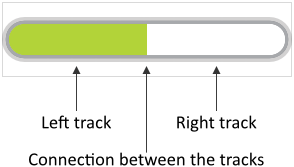
This truncation is not always desired. Depending on the design of your individual value bar, it can be necessary to always display the whole track inclusive its both end caps. This can be controlled by modifying the properties TrackLeftWithEdge and TrackRightWithEdge. If you assign the value true to the property TrackLeftWithEdge, the left track is not truncated anymore. It appears with its all edges. Similarly, if you initialize TrackRightWithEdge with true, the right track is not truncated. You can also combine both. The following figure demonstrates the effect of these properties:
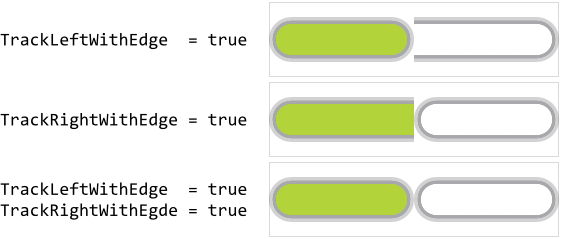
Specify the bitmap and color for the Value Bar's needle image
As explained in the section above the Needle view is displayed centered at the actual needle position within the value bar's area. With the following properties you specify the bitmap resource as well as other parameters to be used by this view. In other words, you use them to configure the appearance of the needle image in the foreground of the value bar:
Property |
Description |
|---|---|
With this property you specify the bitmap resource the Horizontal Value Bar has to display in its foreground Needle view. |
|
This property is relevant only if the bitmap resource specified in the above described property Needle contains more than one frame. In such case you use it to determine the desired frame number. Is the bitmap additionally configured as containing an animated sequence you can initialize the NeedleFrame property with the value -1 to instruct the Horizontal Value Bar to automatically play the animation. |
|
The effect of this property depends on the type of the bitmap resource specified in the above described property Needle. In case of an alpha-only bitmap you use the property to determine the color to tint the bitmap. In all other cases you can use the alpha value of the NeedleTint property to simply modulate the opacity of the bitmap. |
The specified bitmap will appear centered vertically and horizontally at the position resulting from the value bar's current value. This corresponds to the position where the left and right tracks join together. The needle overlays this position.
If you leave the property Needle initialized with null, the Horizontal Value Bar will appear without any needle. In this case, the length of the left and/or right tracks express the value bar's actual position.
Specify the margins for the Value Bar's needle
Per default, the needle can move freely across the entire width of the Horizontal Value Bar. If this is not desired, you can specify in the properties NeedleMarginLeft and NeedleMarginRight additional gaps in pixel between the needle image and the respective left or right edge of the value bar. The following figure demonstrates the effect of these properties (the gray borders indicate the areas of the respective value bar):
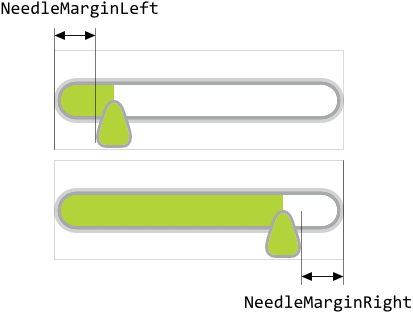
Please note, if your Horizontal Value Bar is configured to appear without any needle, the specified margins are still valid. The properties NeedleMarginLeft and NeedleMarginRight determine in this case the minimal distances between the position where the both tracks join together and the respective left or right edges of the widget. In other words, by using the properties you can specify the minimum width for the corresponding left and right tracks.
Specify the bitmap and color for the Value Bar's cover image
As explained in the section above the Cover view occupies vertically centered the entire width in the foreground of every Horizontal Value Bar. Thus as its name indicates, it is intended to be used as a kind of cover, mask, etc. overlaying the needle and the tracks. With the following properties you specify the bitmap resource as well as other parameters to be used by this view. In other words, you use them to configure the appearance of the Horizontal Value Bar's foreground:
Property |
Description |
|---|---|
With this property you specify the bitmap resource the Horizontal Value Bar has to display in its foreground Cover view. |
|
This property is relevant only if the bitmap resource specified in the above described property Cover contains more than one frame. In such case you use it to determine the desired frame number. Is the bitmap additionally configured as containing an animated sequence you can initialize the CoverFrame property with the value -1 to instruct the Horizontal Value Bar to automatically play the animation. |
|
The effect of this property depends on the type of the bitmap resource specified in the above described property Cover. In case of an alpha-only bitmap you use the property to determine the color to tint the bitmap. In all other cases you can use the alpha value of the CoverTint property to simply modulate the opacity of the bitmap. |
The specified bitmap will fill vertically centered the entire width of the Horizontal Value Bar. This is achieved by so-called 9-slice image scaling technique where the intended destination area is filled with slices copied from the original bitmap. In case of the Horizontal Value Bar, however, the slices are copied horizontally only. In the vertical direction, the bitmap retains its original height and it is just centered within the value bar's area. Therefore, if you want the Horizontal Value Bar to be flexibly resizable, you have to ensure that the used Cover bitmap is composed of three equally sized slices arranged in a single row as shown in the following figure. You should consider this aspect when designing the bitmap in a graphic editor:

In turn, if the bitmap in the foreground of your Horizontal Value Bar is intended to always have the same fixed width, you can ignore the above bitmap design restrictions. Just design your desired bitmap and explicitly define size constraints for the widget itself to ensure, that its width is fixed and it corresponds to the of the used Cover bitmap.
If you leave the property Cover initialized with null, the Horizontal Value Bar will appear without any foreground.
Configure the animation effect for the Value Bar
The Horizontal Value Bar widget implements an effect to react to changes of the widget's current value with an animation. Accordingly, the needle does not jump when the value changes. Instead, it slides smoothly between its actual and the new position.
The maximum time how long the animation should take can be configured as a value in milliseconds in the property SwingDuration. However, the real duration is proportional to the actual distance to move the needle. The shorter the distance, the faster the animation. If this animation effect is not desired in your individual Horizontal Value Bar widget, initialize the property SwingDuration with the value 0.
With the further property SwingElastic you can configure the timing (the easing) for the animation effect. If this property is false, the animation will be performed with the ordinary FastIn_EaseOut timing. In turn, if you initialize the property SwingElastic with the value true, the animation will be performed with the more sophisticated BackOut timing resulting in the animation having characteristic similar to a physical object with its mass and inertia.
Configure the Horizontal Value Bar size constraints
With the both properties WidgetMinSize and WidgetMaxSize you can configure size constraints for all Horizontal Value Bars using your configuration object. For example, if your Horizontal Value Bars can not become smaller than 100x50 pixel, initialize the property WidgetMinSize with the value <100,50>. Similarly, by initializing the property WidgetMaxSize you determine the maximum size the value bars may assume at the runtime. Trying to resize the value bars beyond the specified size constraints will be automatically suppressed.
Per default, the properties are initialized with the values <0,0> which means, that no constraints have to be taken in account. If desired, you can also specify constraints only for the width or the height of the value bar. For example, if your value bars are flexibly resizable in the horizontal direction but they should have fixed height of 100 pixel, you initialize the both properties with the value <0,100>.
Modify provided default Horizontal Value Bar Config objects
The above sections explained how you create and configure your own Horizontal Value Bar Config objects practically from scratch. This is usual when you have your own GUI design. However, if you prefer to use the configurations provided per default with Embedded Wizard and you want only few settings to be changed, it is more convenient to create a copy of the existing configuration object and adapt the affected property only. Let's assume you want to use the WidgetSet::HorizontalValueBar_Large configuration but with different margins on the left and right of the needle. In such case do following:
★As explained in the section Duplicate an existing autoobject locate the object WidgetSet::HorizontalValueBar_Large and copy it to one of your own project units.
★Rename the just created copy to not confound it with the original object.
★As long as the copied object is selected you can inspect and modify its properties conveniently in the Inspector window. Change its property NeedleMarginLeft and NeedleMarginRight now.
★Once you have adapted all properties as expected, you can assign the copied configuration object to every affected Horizontal Value Bar.
CAUTION
Directly modifying the original configuration objects provided with Embedded Wizard is not recommended. The objects are part of the Mosaic framework and Embedded Wizard will prevent you from being able to save any modification made in this framework. Therefore always create and modify copies of the objects.
